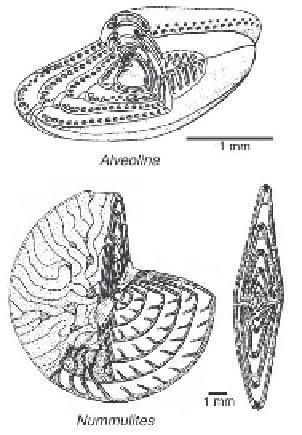Geology Reference
In-Depth Information
Plate 74 Tertiary Nummulitid and Alveolinid Limestones
Foraminifera are represented in thin sections of Tertiary limestones by benthic and planktonic forms (Pl. 74/9,
10). Of particular interest are benthic larger foraminifera, including the Nummulitacea (-> 2-5; Pl. 75/1, 2, 6-8;
hyaline calcareous rotaliinids, common in shallow inner platform settings and sometimes associated with reefs)
and the Alveolinacea (-> 1, 9; Pl. 75/3-5; porcelaneous calcareous miliolinids, common in shallow lagoonal
platform settings). These groups have millimeter- to centimeter-sized tests with complex endoskeletal structures
which must be studied in oriented thin sections. Axial sections show whorls, the character and dimensions of the
chambers and the distribution of pillars. Equatorial sections display growth character of whorls, the number and
shape of septa and character of initial chambers. Living and extinct taxa evolved in tropical or subtropical
habitats. The taxonomic differentiation needs sections showing the size and shape of the test, the morphology of
the initial and embryonal chambers, the character of the whorls, shape and number of septa as well as dimen-
sional features. The lenticular and discoidal hyaline Nummulitidae occur in rock-building abundance. A famous
example is the carbonate rock used in building the great Cheops pyramide in ancient Egypt. Nummulitids and
alveolinids are index fossils for the biozonation of Early Tertiary shallow inner platform and shelf edge carbon-
ates. Other stratigraphically significant groups are the rotaliinids include the Lepidocyclinidae (-> 7-8, Middle
Eocene to Early Miocene) and Miogypsinidae (-> 6, Middle Oligocene to Early Miocene).
1
Alveolina
d'Orbigny. The Alveolinidae, known from the Early Cretaceous up
to today, have imperforate calcareous tests of porcelaneous appearance. Coil-
ing is fusiform to ovate planispiral. Chambers are divided by septulae into
numerous chamberlets arranged in one or more rows. Genus range: Late Pale-
ocene to Late Eocene. Early Tertiary (Eocene): Slovenia.
2
Nummulites
Lamarck. Nummulitidae are characterized by radial hyaline and
perforate tests with septa. Coiling is biconvex planispiral. Chambers may be
simple or differentiated into median and lateral layers. The sample is a fora-
miniferal packstone consisting predominantly of
Nummulites
. Dense pack-
ing, poor sorting and the minor amount of micrite indicate postmortem al-
lochthonous deposition by high energy events. The thin section shows axial
sections (A), equatorial sections (E) and random sections. Genus range: Pale-
ocene to Holocene, abundant in Eocene. The maximum distribution of
nummulitid facies is in the Middle Eocene. SMF 10. Early Tertiary (Eocene):
Southern Bavaria, Germany.
3
Assilina
d'Orbigny. Nummulitacea. Large evolute tests with rapidly enlarg-
ing whorls and numerous chambers per whorl. Genus range: Paleocene to
Holocene, common in Eocene. Early Tertiary (Eocene): Gorica, Slovenia.
4
Discocyclina
Gümbel. Nummulitacea. Tests are radial hyaline and perforate.
A median layer of chambers is differentiated from lateral chambers. Radiat-
ing pillars give rise to granules on the outer surface. Genus range: Late Paleocene to Late Eocene. Example:
Discocyclina
(D, axial section) associated with
Nummulites
(N). Early Tertiary (Eocene): Southern Bavaria, Germany.
5
Operculina
d'Orbigny
.
Nummulitacea.
Planispiral flattened test. Wall calcareous, lamellar, finely perforate. Note imbri-
cation structure indicating current transport. Genus range: Oligocene to Holocene. Miocene: Ekisce, southern Turkey.
6
Miogypsina
Sacco. Rotaliina, Rotaliacea. Transverse sections. The Miogypsinidae are excellent index fossils for the
Middle Oligocene to Early Miocene time interval (Abdelghany and Piller 1999). The genus is tolerant of terrigenous
influx. It occurs both in lagoon and shallow subtidal environments of open platform. The sample is a foraminiferal
packstone exhibiting an accumulation of foraminifera, bryozoan debris (bottom) and red algal fragments (black). Oli-
gocene: Southern Turkey.
7
Lepidocyclina (Eulepidina) ephippioides
Jones and Chapman. Rotaliina, Asteriginacea, Lepidocyclinidae. Vertical sec-
tion of a macrosphere. Note central initial chambers and densely spaced median chambers. The shape of the median
chambers is the diagnostic criterion. Lepidocyclinidae are common in lagoons and shallow subtidal environments. Ge-
nus range: Middle Eocene to Early Miocene. Oligocene: Argyrotopos, Epirus, western Greece.
8
Lepidocyclina (Eulepidina) eodilatata
Douvillé. Vertical section of a microsphere (bottom). Same locality as -> 7.
9
Borelis melo
(Fichtel and Moll). Tangential section. Miliolina, Alveolinacea. Small spherical test. Note numerous septula
aligned from chamber to chamber. Genus range: Eocene to Holocene. Miocene: Kasaba, southern Turkey.
10 Encrusting foraminifera:
Miniacina
Galloway, arrows (Rotaliina, Acervulinidae) intergrown with coralline red algae
(black). Rasberry-like clusters of globular chambers. Acervulinid foraminifers contribute to the formation of composite
rhodoids and reef carbonates. Genus range: Eocene to Holocene. Paleocene: Slovakia.
-> 5, 6, 9: Courtesy of M. Link (Erlangen); 7, 8: Bellas et al. 1995. Figure on this page from Bignot (1985)

